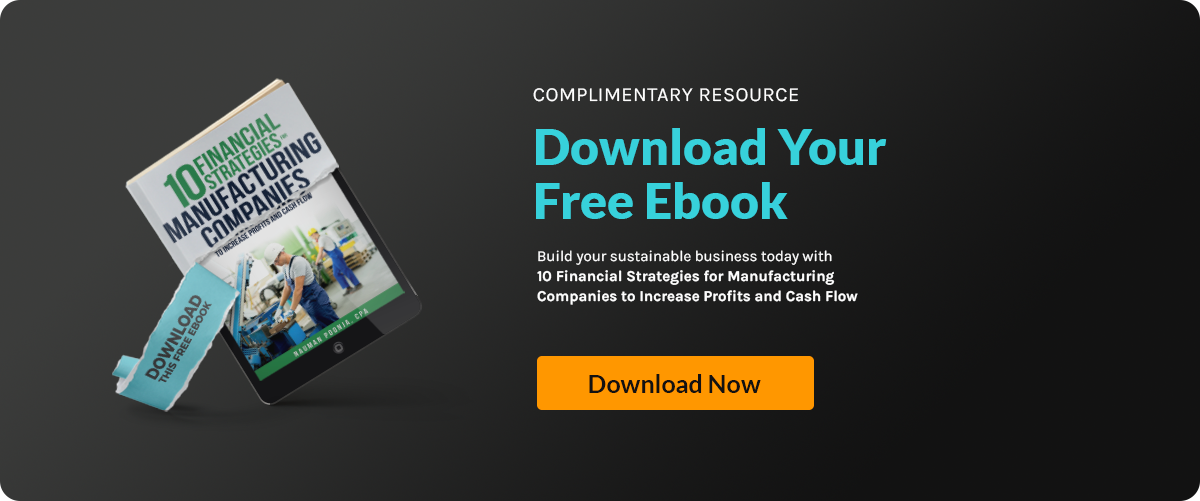For founders, growth starts and ends with cash. You can have steady sales, expanding operations,...
Financial Modeling vs. Forecasting

For manufacturers, growth depends on more than production efficiency—it depends on financial clarity. Every strategic decision, from buying new machinery to hiring staff, starts with one question: What will this cost, and what will it return?That’s where financial modeling and forecasting come in. These tools turn data into direction, helping leaders anticipate outcomes and make confident decisions. Yet, they’re often misunderstood—or used interchangeably when they serve very different purposes.
In this guide, we’ll unpack the difference between financial modeling and forecasting, explain how each supports manufacturing growth, and show why using both together gives your business a competitive edge.
Why This Distinction Matters for Manufacturers
Manufacturing thrives on precision. You plan production schedules, manage suppliers, and allocate labor based on exact measurements. Finance should work the same way.
Without accurate models and forecasts, even strong companies misjudge capacity, overspend on materials, or miss expansion opportunities. The right financial framework ensures your budgets, investments, and operations align with growth goals.
It’s no coincidence that scalable manufacturers invest heavily in financial planning and control processes and advanced analytics—because the clearer the numbers, the faster you can grow with confidence.
What Is Financial Forecasting?
Financial forecasting is about expectations. It estimates future performance based on historical data and current trends.
In manufacturing, a forecast might predict:
- Monthly revenue for each product line
- Expected production costs per quarter
- Future cash flow or capital needs
Forecasting gives you a realistic picture of where your company is heading if current trends continue. It’s your baseline for planning.
Most manufacturers use rolling forecasts—updated every month or quarter—to stay agile. Learn how this approach supports agility in how rolling forecasting gives manufacturers a competitive edge.
Types of Forecasts
-
Short-Term Forecasts (0–12 months)
Used for budgeting, cash management, and inventory planning. -
Medium-Term Forecasts (1–3 years)
Support operational scaling and hiring plans. -
Long-Term Forecasts (3–5 years)
Inform strategic investments and capital planning for profitability.
Forecasting tells you what’s likely to happen. But what if you want to test what could happen? That’s where financial modeling comes in.
What Is Financial Modeling?
While forecasting projects one path forward, financial modeling lets you build multiple possible futures. It’s a dynamic, data-driven simulation that helps you test “what-if” scenarios before they happen.
For example, a CFO might model:
- What happens to margins if material prices increase 10%
- The financial impact of adding a second shift
- The ROI of buying new automation equipment
These models combine assumptions, cost drivers, and real data into structured calculations that forecast outcomes for each scenario.
In other words, forecasting predicts, while modeling experiments.
How They Work Together
Think of forecasting as your compass—it points you in the right direction. Financial modeling is your map—it shows multiple routes to your destination.
Forecasts depend on accurate models. The model defines the logic behind your numbers—how costs behave, how revenue changes with demand, and how operational adjustments affect profitability.
When CFOs or controllers develop budgets, they often start with a base forecast, then use modeling to test decisions against it. This process ensures financial resilience under changing conditions.
That’s the foundation of strategic finance—an approach detailed in fractional CFOs in manufacturing.
Why Forecasting Alone Isn’t Enough
Relying only on forecasting gives you a one-dimensional view of your finances. It assumes that the future will behave like the past, which is rarely true in manufacturing.
Forecasts miss:
- Market disruptions or material shortages
- Unexpected equipment downtime
- New pricing or wage regulations
Financial models prepare you for these changes by stress-testing assumptions. They help manufacturers respond, not react.
By combining forecasting with modeling, you turn your finance function from reactive bookkeeping into forward-looking strategy.
Building a Financial Model for Manufacturing
To read your data like a CFO, you must build models tailored to your operation’s key drivers.
Step 1: Identify Core Inputs
List the variables that most impact profitability—material cost, production hours, machine utilization, and labor rates.
Step 2: Build Relationships
Determine how each variable affects others. For instance, higher production hours may reduce per-unit cost but raise energy and maintenance expenses.
Step 3: Add Real Data
Pull numbers from your accounting system, profit and loss statement, and cost of goods sold analysis.
Step 4: Create Scenarios
Model outcomes for best case, worst case, and most likely conditions.
Step 5: Review and Adjust
Validate results against actuals monthly and refine assumptions continuously.
CFOs treat this as a living model, not a one-time report.
How Modeling Supports Manufacturing Growth
A robust financial model lets CEOs and CFOs:
- Evaluate ROI for new investments or equipment purchases
- Optimize pricing and margin analysis
- Forecast cash flow under different demand conditions
- Manage debt and capital allocation
For growing manufacturers, this insight drives smarter expansion—avoiding overextension while maximizing return.
Real Example
A mid-sized metal fabrication company considered adding a second facility. Their forecast showed rising revenue but tight cash flow.
After building a model factoring in financing costs, labor expenses, and potential machine downtime, they discovered they’d need 18 months of positive cash flow before expansion was viable.
That insight saved them from a cash crunch and helped secure financing when the timing was right.
This is the practical power of financial modeling—it turns data into confident decisions.
The CFO Approach to Forecasting
CFOs don’t just create one forecast and move on—they treat forecasting as a continuous improvement cycle.
They use models to:
- Track actual vs. projected performance
- Update assumptions with market data
- Reforecast based on real-time results
This approach is detailed in manufacturing financial forecasting and capital purchase plans.
When forecasts and models evolve together, leadership stays proactive rather than reactive.
How to Implement Both in Your Finance Function
1. Start with Clean Data
Accuracy starts with sound bookkeeping and standardization—use systems outlined in manufacturing accounting services.
2. Use Technology
Automate your data collection and forecasting through integrated ERP systems and dashboards.
3. Build Scalable Processes
Establish forecasting templates and model frameworks that can grow with your company.
4. Collaborate Across Departments
Operations, finance, and sales must align assumptions—especially around lead times, pricing, and capacity.
5. Get Expert Oversight
If internal resources are limited, partner with an outsourced team that offers both accounting and modeling expertise. Learn how this works in benefits of outsourced accounting services for manufacturing companies.
Common Mistakes to Avoid
-
Treating Forecasts as Fixed Truths
Forecasts are guides, not guarantees. Update them regularly. -
Using Generic Models
Manufacturing requires industry-specific cost structures and performance metrics. -
Ignoring Scenario Planning
Without modeling best- and worst-case outcomes, you risk surprises. -
Focusing on Revenue Only
Growth means little without profitability. Track margins and overhead closely. -
Neglecting Automation
Manual forecasting leads to delays and data errors. Automate wherever possible using accounting automation tools.
How Both Drive Sustainable Growth
Forecasting Fuels Planning
It gives visibility into what’s coming—helping manufacturers manage inventory, schedule production, and plan staffing.
Modeling Fuels Strategy
It lets you test new ideas safely—expansions, pricing changes, or debt financing—before committing real money.
Together, they create a cycle of insight and agility that drives sustainable profitability.
As highlighted in why strategic financial planning matters in manufacturing, companies that integrate both functions outperform those relying on gut instinct or outdated spreadsheets.
Key Takeaways for CEOs
| Function | Purpose | Best For |
|---|---|---|
| Forecasting | Predicting future results | Budgeting, goal setting, managing expectations |
| Modeling | Testing financial outcomes under different conditions | Strategic decisions, investments, pricing |
| Combined | Provides both direction and insight | Growth planning and risk mitigation |
CEOs who master both approaches don’t just react to market shifts—they anticipate them.
The Bottom Line
Neither modeling nor forecasting stands alone. Forecasting keeps your team grounded in current trends. Modeling pushes you to plan for the unexpected. Together, they form the core of a scalable, data-driven finance function.
For manufacturing leaders focused on growth, using both is not optional—it’s essential.
Want to bring CFO-level financial clarity to your manufacturing business?
Contact Accounovation to build stronger forecasts, smarter financial models, and sustainable growth strategies.







